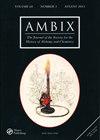Making Physicians: Tradition, Teaching, and Trials at Leiden University, 1575–1639
IF 0.3
3区 哲学
Q3 HISTORY & PHILOSOPHY OF SCIENCE
引用次数: 0
Abstract
as well as his later rebellion against an academic career in Ghent, which he found stultifying, preferring to try his luck in America, with long absence from, and consequent negative impact on, his marriage to Céline Swarts. Mercellis dispels some myths, notably that Baekeland earned $750,000 by selling his invention of Velox photographic paper in 1899 to Eastman Kodak. In actuality, he shared this sum with two partners, Leonard Jacobi and Albert Hahn, making only $215,000 from the deal, which was nonetheless sufficient to set him up as an independent researcher. When he later referred to this period in his life and the sale of his interests in the Nepera Chemical Company, Baekeland failed to mention any partners, only using the pronoun “I” in his presentations, consequently gaining all the reputational benefit. Somewhat of an academic elitist, he nonetheless valued the practical approach rather than the theoretical, rejecting those in an academic “ivory tower” (p. 54). Baekeland made money in business but was careful to avoid mention of this when talking in academic circles, where he often focused on theoretical rather than practical approaches, postulating theories about the structure of his phenolic resins, which were later proven to be very much off the mark. He promoted industrial chemistry as “a service to society” (p. 183), regarding science and technology as superior in social and cultural value to literature and art, an opinion which did not endear him to some of his peers and provoked debate. However, as an entrepreneur of his time, he benefited from the increasing popularity of science and technology in the contemporary zeitgeist. The book is enriched by the use of a range of primary archives, notably sources in Ghent, Belgium, and better-known records in the United States. This research will be invaluable to historians of technology and the history of science.培养医生:莱顿大学的传统、教学和试验,1575-1639
以及他后来对根特的学术生涯的反抗,他觉得那里的学术生涯很无聊,他更喜欢在美国碰碰运气,长期缺席,并因此对他与csamline Swarts的婚姻产生了负面影响。梅尔塞利斯打破了一些神话,尤其是贝克兰在1899年把他发明的Velox相纸卖给伊士曼柯达(Eastman Kodak),赚了75万美元。实际上,他与两位合伙人伦纳德·雅可比(Leonard Jacobi)和阿尔伯特·哈恩(Albert Hahn)分享了这笔钱,从这笔交易中只赚了21.5万美元,尽管如此,这笔钱足以让他成为一名独立的研究人员。当他后来提到他生命中的这段时间和他在Nepera化学公司的股份出售时,贝克兰没有提到任何合作伙伴,只是在他的演讲中使用代词“我”,因此获得了所有的声誉利益。作为一名学术精英,尽管如此,他还是重视实践方法而不是理论方法,拒绝那些在学术“象牙塔”里的人(第54页)。贝克兰做生意赚了钱,但在学术界讲话时,他小心翼翼地避免提及这一点。在学术界,他经常关注理论而不是实际方法,假设他的酚醛树脂结构的理论,后来被证明是大错特错的。他提倡工业化学是“对社会的服务”(第183页),认为科学和技术在社会和文化价值上优于文学和艺术,这一观点并没有使他受到一些同行的喜爱,并引发了争论。然而,作为他那个时代的企业家,他受益于当代时代精神中科学技术的日益普及。这本书是丰富了一系列主要档案的使用,特别是在根特,比利时的来源,以及在美国更知名的记录。这项研究对技术史家和科学史学家来说是非常宝贵的。
本文章由计算机程序翻译,如有差异,请以英文原文为准。
求助全文
约1分钟内获得全文
求助全文
来源期刊

Ambix
HISTORY & PHILOSOPHY OF SCIENCE-
CiteScore
0.80
自引率
60.00%
发文量
42
审稿时长
3 months
期刊介绍:
Ambix is an internationally recognised, peer-reviewed quarterly journal devoted to publishing high-quality, original research and book reviews in the intellectual, social and cultural history of alchemy and chemistry. It publishes studies, discussions, and primary sources relevant to the historical experience of all areas related to alchemy and chemistry covering all periods (ancient to modern) and geographical regions. Ambix publishes individual papers, focused thematic sections and larger special issues (either single or double and usually guest-edited). Topics covered by Ambix include, but are not limited to, interactions between alchemy and chemistry and other disciplines; chemical medicine and pharmacy; molecular sciences; practices allied to material, instrumental, institutional and visual cultures; environmental chemistry; the chemical industry; the appearance of alchemy and chemistry within popular culture; biographical and historiographical studies; and the study of issues related to gender, race, and colonial experience within the context of chemistry.
 求助内容:
求助内容: 应助结果提醒方式:
应助结果提醒方式:


